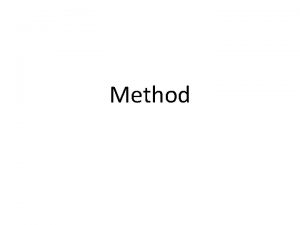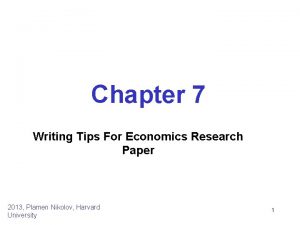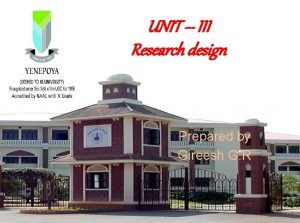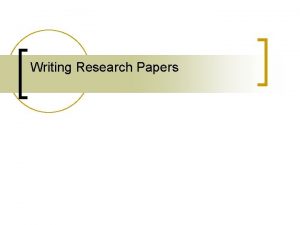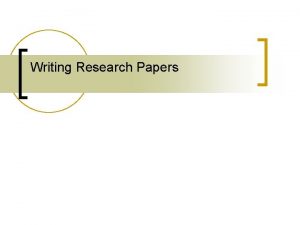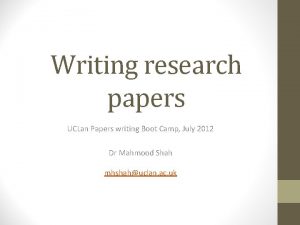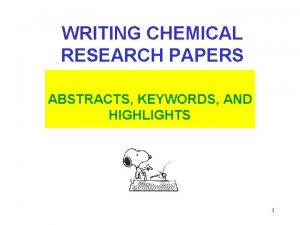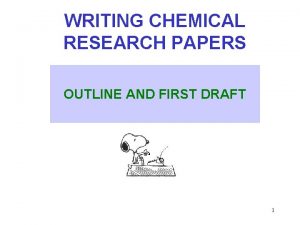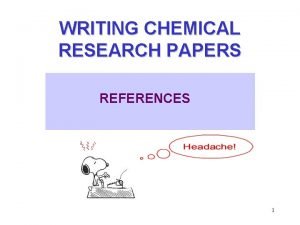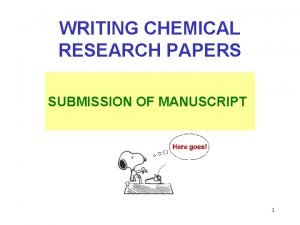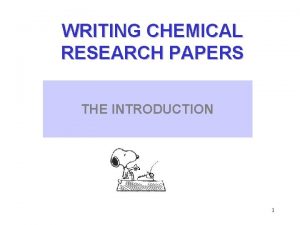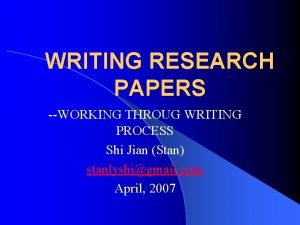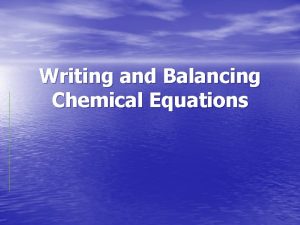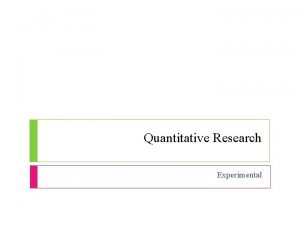WRITING CHEMICAL RESEARCH PAPERS EXPERIMENTAL OR MATERIALS AND



















- Slides: 19

WRITING CHEMICAL RESEARCH PAPERS EXPERIMENTAL, OR MATERIALS AND METHODS 1

Function of ‘Materials and Methods’ or ‘Experimental’ Section • To allow readers to assess the value and quality of your work • To enable readers to repeat or adopt your procedures 2

Function of ‘Materials and Methods’ In general, a Materials and Methods section Should give clearly the following information: • Details of experimental procedure – what was done and how • Details of quantities, times and all relevant parameters and experimental conditions • Details of equipment • Details of materials 3

Structure of Materials and Methods Section The ‘Materials and Methods’ or ‘Experimental’ Section will be normally divided into a number of subsections, according to journal style. Typically these are: • Materials • Instrumentation • (Experimental) Procedures (including General Procedure in organic synthesis papers – see later) • Any addition experimental sections 4

Contents of ‘Materials and Methods Subsections • Materials. Identity, grades and sources (with brief addresses) of key materials should be stated here • Instrumentation. Information should include model names/numbers, manufacturers (with brief addresses) and operating conditions (there may be a separate subsection for this) 5

Contents of ‘Materials and Methods Subsections. . Continued • Procedure. All necessary experimental details (masses, volumes, times, temperatures, etc) should be given here, along with a concise but clear procedural details • See special note on synthetic organic chemistry ‘Materials and Methods’ style 6

Some Important General Points • Set out procedural details in logical order, making them easy for readers to follow • Use subheadings to divide text, according to journal guidelines 7

More General Points • Methods should describe experimental design clearly (but briefly). E. g. -Hypotheses tested -Variables measured -Replicates -Reference materials (standards) 8

Some More General Points • Methods should explain briefly why each procedure was done • Any already published procedure that is important, but not central to the present manuscript, can be merely referenced (especially if lengthy) 9

Yet More General Points • Use past tense in third person • Give clear descriptions of new equipment constructed for your study: include a figure if necessary • Give details of modifications made to standard equipment or existing methods 10

Final General Points (Honestly!) • Emphasize sources of specific materials or equipment that are crucial to the study • State quantifications precisely (and with estimate of error, where relevant) • State statistical tests used (with citation, if special) 11

What Not to Include in ‘Materials and Methods’ • Results: These will be in the ‘Results’ or ‘Results and Discussion’ section • Background information: that should be in the ‘Introduction’ and/or ‘Discussion’ section • Extraneous information or discussion 12

Synthetic Organic Chemistry ‘Materials and Methods’ Style • In the Materials subsection, sources (with brief address) and quality of chemicals should be included, as stated previously • In the Instrumental subsection (if present), instrument model numbers and manufacturer details should be given, as stated previously 13

Synthetic Organic Chemistry ‘Materials and Methods’ Style. . Continued • An Instrumental Procedures subsection (if present) should give essential (but brief) details, including experimental or operating conditions 14

Synthetic Organic Chemistry ‘Materials and Methods’ Style. . Continued In the General Procedure subsection, • Details mentioned above are not included, but details of chromatography stationary and mobile phases should be included, along with other essential details on quantities, temperatures, times, etc • Physical parameters (m. pt. , elemental composition, spectroscopic data, etc) of all new compounds should be summarized in this subsection 15

Example 1 16

Example 2 17

Example 3 18

If in Doubt, Ask a Colleague… 19
 Disadvantages of experimental research
Disadvantages of experimental research Research instrument in experimental research
Research instrument in experimental research Research instrument in experimental research
Research instrument in experimental research Writing tips for economics research papers
Writing tips for economics research papers Experimental vs non experimental
Experimental vs non experimental Experimental research design types
Experimental research design types Experimental vs nonexperimental
Experimental vs nonexperimental Experimental vs non experimental
Experimental vs non experimental Natural materials and man made materials
Natural materials and man made materials Materials that are harmful and useful
Materials that are harmful and useful Man made materials
Man made materials Adopting materials
Adopting materials Properties of dental materials
Properties of dental materials Experimental design xo1
Experimental design xo1 Non experimental research topics
Non experimental research topics Quasi experiment advantages and disadvantages
Quasi experiment advantages and disadvantages Experimental research chapter 2
Experimental research chapter 2 Mini research report
Mini research report Control in experimental research
Control in experimental research Non-experimental/ descriptive design
Non-experimental/ descriptive design


